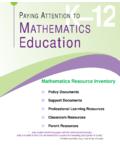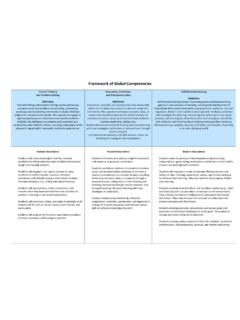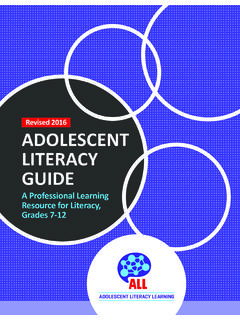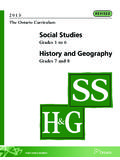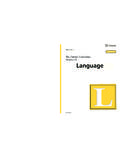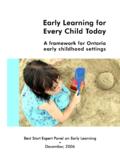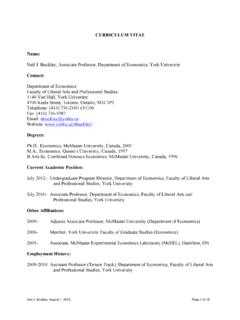Transcription of Water the Gift of Life - Investigating Environmental …
1 1 curriculum and Assessment Policy Branch, ministry of Education 2014 Grade 3 - Water the Gift of life : Investigating Environmental Impacts Social Studies, Grades 1-6; History and Geography, Grades 7 and 8 (2013) Grade 3, People and Environments: Living and Working in Ontario Overview of Module Students gain an understanding of Aboriginal perspectives on nature by exploring the interconnectedness of Water , the environment, and life itself. Students explore how Environmental problems such as pollution and climate change affect Water . Students apply their knowledge of the interconnectedness of Water , human health, and Earth s ecosystems as they consider Water conservation for future generations. Connections to curriculum The curriculum expectations addressed in this teaching and learning example (TLE) are identified within the TLE plan and can also be found in the Ontario curriculum : Social Studies, Grades 1-6; History and Geography, Grades 7-8 (2013), Grade 3, People and Environments: Living and Working in Ontario.
2 Connections to First Nations, M tis and Inuit People and Perspectives Many Aboriginal peoples consider Mother Earth to be connected to their identity. All that comes from Earth sustains people today and for the next generations to come. Water is the life -blood to all living beings and maintaining clean Water is essential for our physical and spiritual health. Many Aboriginal cultures believe that how we use Water today impacts the next seven generations. Aboriginal people believe it is our responsibility to maintain clean Water in dealing with waste management and resource development for the success of future biodiversity. In Anishinaabe and M tis cultures, women are the Water keepers and carry the specific responsibility for Water . Many First Nation and M tis communities participate in Water ceremonies and/or Water Walks to bring awareness to the importance of clean Water and to celebrate the spiritual quality of Water and the life it sustains.
3 Considerations for Planning Teachers may choose to begin the lesson with a short introductory task: Whose land are you on? Many students and community members are unaware of which traditional lands their school is located upon. Maps include: The First Nations and Treaties Map of Ontario a copy 2 curriculum and Assessment Policy Branch, ministry of Education 2014 of which was sent to all schools available at: < >; or a historical map such as the one found at the Canadian Museum of History web page: < > If teachers want to participate in an Extension Activity involving an off-site visit to an Aboriginal community for a Water Ceremony, this would need to be arranged at the beginning of this module. (Board policies for off-site visits would need to be observed, and teachers would have to prepare students for appropriate behaviour during the ceremony. Elders or cultural guides can help teachers to understand expectations.)
4 Students use the components of the social studies inquiry process to investigate, and to communicate their findings about, significant events, developments, and issues. By applying the inquiry process, students develop skills that they need in order to think critically, solve problems, make informed judgements, and communicate ideas. The social studies inquiry process consists of five components: formulating questions, gathering and organizing information, evidence, and/or data; interpreting and analysing information, evidence, and/or data; evaluating information, evidence, and/or data; and drawing conclusions, communicating findings. It is important for teachers to understand that the inquiry process is not necessarily implemented in a linear fashion. Not all investigations will involve all five components; moreover, there are different entry points within the process.
5 curriculum Connections curriculum Overall Expectations curriculum Specific Expectations Grade 3 People and Environments: Living and Working in Ontario B2. Inquiry: use the social studies inquiry process to investigate some of the Environmental effects of different types of land and/or resource use in two or more Ontario municipal regions, as well as some of the measures taken to reduce the negative impact of that use. formulate questions to guide investigations into some of the short- and/or long-term effects on the environment of different types of land and/or resource use in two or more municipal regions of Ontario and We are learning to: investigate our Water supply by asking good questions. explore how our short- and long-term actions affect the Water supply. discover how Aboriginal peoples view, care for, and celebrate, Water . identify ways that we can reduce the negative effects of pollution on our Water supply.
6 Sample Success Criteria I will know I am successful when I can: ask good questions that help us to learn more about Water . 3 curriculum and Assessment Policy Branch, ministry of Education 2014 curriculum Overall Expectations curriculum Specific Expectations measures taken to reduce the negative impact of that use. gather and organize a variety of data and information on the Environmental effects of different land and/or resource use and measures taken to reduce the negative impact of that use. interpret and analyse information and data relevant to their investigations, using a variety of tools. evaluate evidence and draw conclusions about some of the short- and long-term effects on the environment of different types of land use in municipal regions of Ontario and about key measures to reduce the negative impact of that use. communicate the results of their inquiries, using appropriate vocabulary and formats.
7 Explore how my actions impact the Water supply. explain the ways that Aboriginal peoples view, care for, and celebrate, their Water . name specific ways that we can reduce the pollution of our Water supply. 4 curriculum and Assessment Policy Branch, ministry of Education 2014 Getting Started Learner Readiness Knowledge and understanding: information on the major landform regions in Ontario the connection between the features of the natural environment and the type of land uses practiced there Terminology Turtle Island Water ceremony consequences Environmental responsibility relationships interrelationships stewardship interdependence watershed investigate explore discover identify landforms inquiry Materials Coloured markers Chart paper Books, photos, and resources about Water music (Aboriginal musician/singer) Resources listed at the end of the TLE Relevant Backgrounders Water the Gift of life .
8 Investigating Environmental Impacts 5 curriculum and Assessment Policy Branch, ministry of Education 2014 Minds On Connections Water Word Clue Activity Distribute one word clue to each student. (See suggested list in Reproducible 1 Water Word Clues.) Students will circulate to music until the music stops. Then students talk to a partner about their clue, trying to figure out what their clue means, and how their clue might fit with another student s clue. Students repeat this process a number of times. Then ask students to guess what topic they think the class will be exploring, and the reasons for their guesses. (Assessment of, as and for Learning; Tips; Differentiation) Differentiation Carefully select and discuss Water Word Clues to be assigned to ELL and students with Special Education needs before the activity begins. A for L: As students are talking to one another, the teacher listens and takes note of the questions that students are asking.
9 Use these questions as samples when giving explicit instruction on how to ask investigative questions. Teachers can also take note of words and concepts that students are unfamiliar with and ensure that these are explained after the activity. Action! Connections Part 1 Brainstorm On chart paper create a brainstorm web that includes everything students know about Water , including what they learned from the Water Word Clues activity. Suggested prompts include: Where does our Water come from? In what ways is Water important? How do we keep our Water safe to drink? What things can pollute our Water ? What happens to communities and people when Water becomes unsafe? A for L: During the brainstorming session listen for student knowledge of this topic. Part 2 Aboriginal Perspectives on Water Aboriginal perspectives on Water may differ from that of non-Aboriginal peoples.
10 It is important that N/A 6 curriculum and Assessment Policy Branch, ministry of Education 2014 Action! Connections students understand that in the Western world, Water may be seen as a commodity to be bought and sold. To Aboriginal peoples, however, Water is seen as the very lifeblood of survival, and therefore it needs to be nurtured and celebrated. Allow opportunities for students to learn about Aboriginal perspectives on Water . Possible sources of information include: Crisis On Tap: First Nation Water for life , (video), < > Indian and Northern Affairs Canada. (2006). Unit 3. Water : Its Many Uses . In The Learning Circle: Classroom Activities on First Nations in Canada, Ages 8 11, < and > Mother Earth Waterwalk -The Water Song < > Toronto Zoo - Ways of Knowing Earth s Teachings Guide & Educational Bundle, < > Waterlife. (2009). Director Kevin McMahon.




